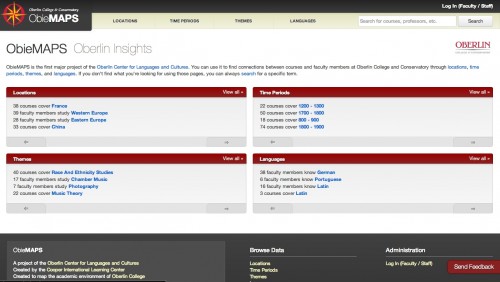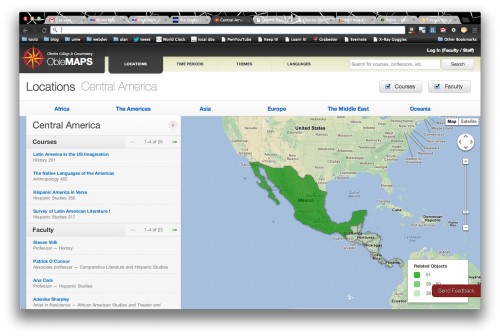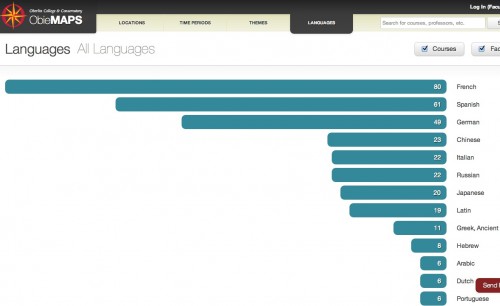
cc licensed ( BY NC SD ) flickr photo shared by listentothemountains
It’s that lingering computer time before dinner, the window where you should really wrap things up if you do not want to be eating at 10:00pm. In her kitchen, making soup, Barbara Sawhill asks “Have you seen our ObieMaps project?”
Hence I fall into a glorious rabbit hole of exploration, where the sound echoing down the tunnels is “Wow… wow.. WOW… WOWOWOWOWOW.”
Barbara directs the Cooper International Learning Center at Oberlin College, located in a quintessential college town 30 miles west of Cleveland. From what she explained, a Mellon grant has funded the new Oberlin Center for Languages and Culture with the first project being ObieMaps:
It is meant to make it much easier for anyone on and off campus to see connections across departments and programs in terms of geography, time periods, themes, or topics. It is a showcase for Oberlin’s many connections with the world, and for our collective language skills.
In a more general sense, ObieMAPS allows the public to get a better sense of the richness and diversity of intellectual life on campus, and the global nature of Oberlin as an institution. ObieMAPS allows anyone to see in one click, for instance, what Oberlin faculty specialize in South-East Asia, who can read French, who works on the Middle Ages, or what courses deal with photography. The main idea is to group or link courses and faculty not through the administrative structures that happen to house them, but the actual content of their courses and intellectual or artistic projects.
What they have done is combined several data sources including course catalogs, faculty profiles, and their one open access catalogs to create a multi-dimensional map of academics at Oberlin. They are literally breaking down the normal silos of departments to make it easier to navigate and explore.
Obiemaps offers entries to this data on four planes – Location (geographic location of class subjects), time periods (covered by classes), themes, and languages, and doorways to view by classes that cover them or faculty that teach them. This leads to paths of exploration such as:
- 23 faculty that explore Central America
- 32 courses that cover Germany
- 50 courses that study the period 1700-1800
- 19 courses that cover the period 1000-1000
- 22 courses that cover music theory
- 18 faculty members that cover Gender and Sexuality
- 14 faculty members that know Russian
- 7 courses that cover the ancient Greek language
That’s just the first layer. Let’s drill into the Oberlin courses that cover Central America:
The map lists course from Anthropology, Hispanic Studies, and History just to name a few. You can follow down into one course Hispanic America in Verse (Hispanic Studies 356) listing all the times it has been taught since 2007, linking to the instructors who taught it, and tying into themes, time periods and languages via tags.
And as you scroll down, it lists other courses that are related along these same axes of time period, subject, theme, etc.
The same paths lead you to explore faculty, e.g the instructor of the Hispanic America in Verse course, Ana Cara. The links include department pages, courses taught, disciplines taught. But there is more, links at the top jump over to Oberlin’s Shares database, (another stunning resource, it is their open access repository of faculty publications) where we can see all of Ana’s publications available in Shares
And like courses, the faculty page for Ana provides a listing of “similar faculty” based again on subjects taught, geographic locations or time periods covered etc.
This map is one that smartly connects faculty, courses, disciplines across an entire institution. It takes your regular web based catalog and faculty directory and blows it up lie a TNT charge.
Look, more! Check out the languages browser, the place to go to directly explore languages covered in Oberlin courses.
We get again all courses related to our teaching Japanese and faculty who know or teach it.
I have to say, this clever connection of data from several resources, one of them the existing college catalogs, another the open access repository, and the third adding some keywords to faculty profiles yields something amazing. Actually, just their commitment to open access publishing is extra commendable.
I cannot say I have seen anything like it, all from this small (< 3000 student) liberal arts college in Ohio.
Imagine, dream, if something like this could be done across institutions?
All of this is stuff flying under the radar of most any coverage or attention. Not for long. This is big stuff, more interesting than "analytics" of logins and counting discussion posts, a meaningful use of relational data.
Map this.

cc licensed ( BY ) flickr photo shared by fdecomite




